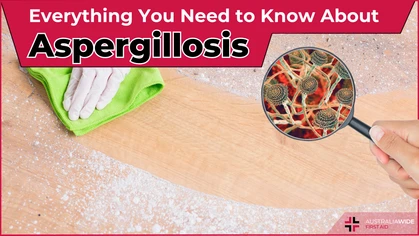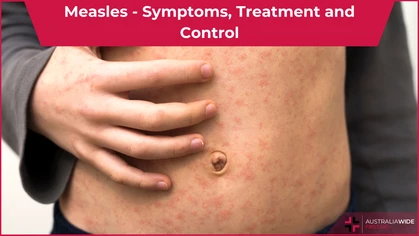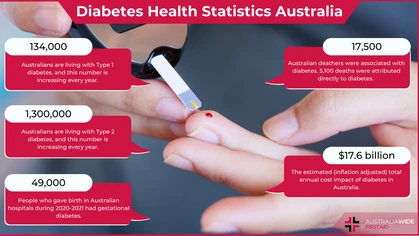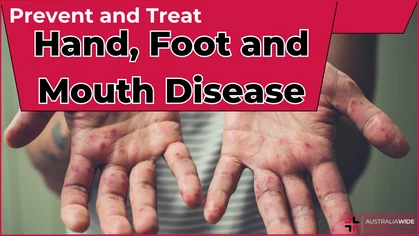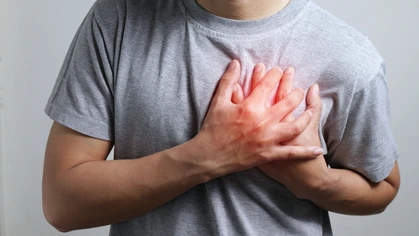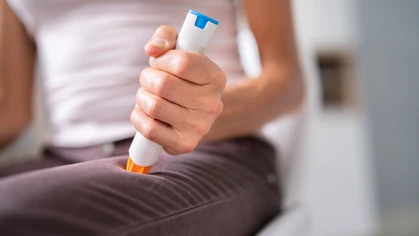Heart Attack First Aid

Disease

A heart attack is a medical emergency. Waste no time calling 000 to request an ambulance.
A heart attack is a medical emergency. The aim of administering first aid treatment for a heart attack is to prevent cardiac arrest - where the heart stops beating. Time is of the essence and when the symptoms suggest a heart attack, it’s better to waste no time calling 000 and requesting an ambulance.What to do if someone is having a heart attack?
Every minute counts. Call 000, even when it’s not yet clear it’s a heart attack.- Make sure the person is at rest and in a comfortable position
- If the person has prescribed medication, such as for chest pain, help them take this, as directed
- Stay with the person until the ambulance or paramedics arrive
- Give Aspirin (dispersible aspirin is preferred – 300mg) if directed by medical professionals
- Administer oxygen, if you are CPR trained, for shortness of breath
- If the person is unresponsive and not breathing normally, follow the DRSABCD chart below.
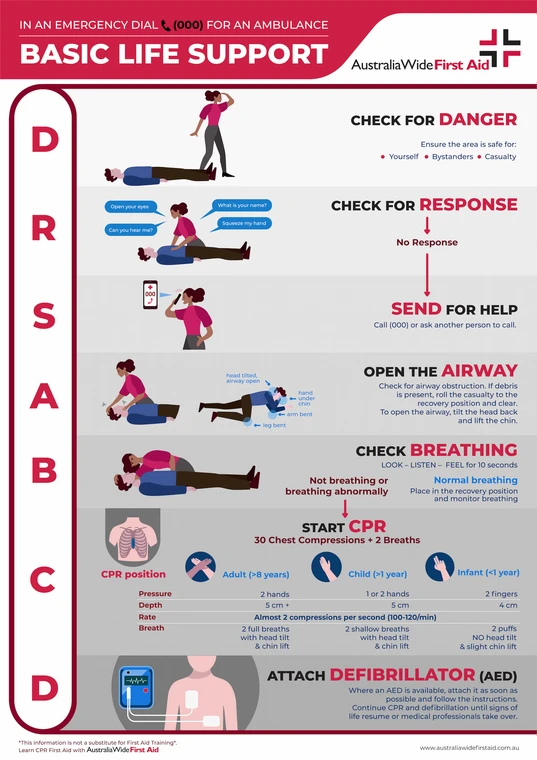
What is a heart attack?
Heart attack — myocardial infarction (clinical term) — is a result of blood flow to the heart being blocked. Coronary heart disease is the most common cause. Over time, fatty deposits can build up in arteries as plaque (atherosclerosis). A piece of this plaque can break off and cause a blockage (blood clot), in turn disrupting oxygen supply to the heart, causing a heart attack. If the coronary artery is not unblocked quickly, the part of the heart nourished by oxygen-enriched blood via that artery normally begins to die. The longer a heart attack goes without treatment, the greater the damage. The heart doesn’t stop beating during a heart attack. However, a heart attack can trigger an electrical disturbance leading to Sudden Cardiac Arrest. You can read more about heart anatomy here.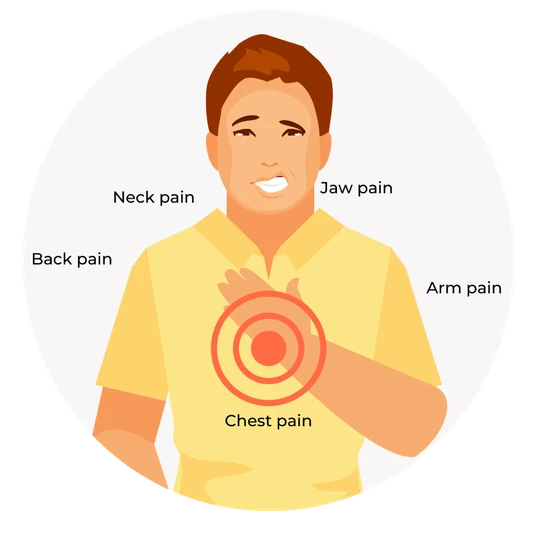
Signs of heart attack
What are the signs of a heart attack?
Symptoms can include sudden chest discomfort or pain (angina). The discomfort can spread to the arms, neck, jaw, or back. Jaw pain is not unusual because the nerves that serve the jaw are close to those that serve the heart. Other symptoms can include sweating or cold sweats, dizziness, light-headedness, or feeling anxious. Nausea, indigestion, vomiting, shortness of breath or difficulty breathing — with or without chest discomfort — can also be experienced. These signs can often begin slowly, worsening over days, weeks, even months, before a heart attack. Chest pain often described as a pressure or squeezing sensation and located at the centre of the chest, is the most common sign among men. This can sometimes be felt from armpit to armpit. Other common heart attack symptoms for men include:- shortness of breath, sometimes developing before any other symptom, possibly present even when sitting still
- back pain, often up to the neck
- arm pain typically left arm but can be in either or both arms
- jaw discomfort that can feel like a toothache
- nausea
- cold sweats
- lightheaded or dizzy
- fatigue that feels flu-like and appears days prior to other symptoms
- upper back burning, tingling, or pressure
- neck and jaw pain — often without chest pain
- pain, tingling, discomfort in either or both arms
- nausea and vomiting
- suddenly short of breath — without exertion, with or without chest pain
What does a heart attack feel like?
Heart attack can feel like uncomfortable pressure, aching, numbness, squeezing, fullness, or burning feeling in the chest. Often, people who’ve had a heart attack mention feeling an uneasy sense of doom they can’t explain. That said, no two heart attacks are the same, even for the same person. The only way to know is to get urgent medical assistance. Heart attacks can be diagnosed by medical tests. You’ll either receive the treatment you need without delay or be relieved to know your problem is not so serious.How long does a heart attack last?
The symptoms can last for several minutes or come and go. A heart attack is a medical emergency. Call 000 immediately, especially when symptoms are severe, worsening, or lasting more than 10 minutes. A Critical Pathways in Cardiology study found that symptoms lasting less than 5 minutes are unlikely to indicate a heart attack. Whereas symptoms lasting longer than 5 minutes should be taken seriously as signs of myocardial infarction (the clinical term for a heart attack). Ask for an ambulance. Treatment can start when ambulance staff arrive, saving precious minutes and preventing damage to the heart — making it the safest way to be taken to hospital.How is a heart attack treated?
Emergency treatment is needed to restore blood flow to the heart. The faster this happens, the less damage to the heart muscle. Heart attack treatment may involve surgery and medications. Surgical procedures can include coronary angioplasty, percutaneous coronary intervention or stents. The procedures involve inserting a long tube (catheter) with a tiny balloon on the end. The entry point can be an artery in your groin, arm or wrist. Guided up into the heart’s artery, the balloon is inflated at the narrowed part of the artery. A small mesh tube (stent) is then inserted to keep the artery open after the catheter is removed. Coronary artery bypass graft surgery takes a healthy blood vessel (or more than one) from the chest, leg or arm, and attaches (grafts) it to the side of the blocked artery. This surgery bypasses the blockage to improve blood flow to the heart. The hospital stay after a heart attack is usually 2 to 5 days, depending on the treatment and the person’s recovery. With prescribed medications, it’s important to stay the course, stopping only if that is the considered advice of your doctor or cardiologist. The medications can include anticoagulant and anti-platelet medicines designed to reduce the blood’s clotting action. Thrombolytics are injected into a vein to dissolve blood clots that may be narrowing or blocking your arteries. Beta-blockers are often prescribed to help relax the heart muscle, slow the heartbeat and lower blood pressure. Blood pressure medications, such as Angiotensin-converting enzyme, and nitrates, widen (‘dilate’) the blood vessels to reduce strain on the heart. Statins are prescribed to reduce the risk of heart attack by helping to lower cholesterol. Disclaimer: This article is for informational purposes only. It does not constitute, replace, or qualify as any form of first aid training.Other Resources
- Step-by-Step CPR for Adults & Older Children
- AED First Aid
- 13 Warning Signs of a Heart Attack That You May Not Know
Sources
Originally published at
https://www.australiawidefirstaid.com.au/resources/heart-attack-first-aid
as part of the Australia Wide First Aid Articles Library



